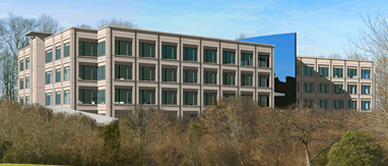
2900 Fairview Park Falls Church, VA
Charlie Haack
Mechanical Option
| Home |
| Charlie Haack |
| Building Statistics |
| Thesis Abstract |
| Technical Assignments |
| Thesis Research |
| Thesis Proposal |
| Presentation |
| Final Report |
| Reflection |
| Senior Thesis E-Studio |
![]()
Building Statistics
Part 1
General Building Data:
Building Name: HITT Contracting Headquarters
Location and Site: 2900 Fairview Park Drive, Falls Church, VA
Building Occupant Name: HITT Contracting
Occupancy and Function: Office Building
Size: 135,000 SF
Number of Stories: 3 above grade/4 total levels
Primary Project Team:
Owner & General Contractor: HITT Contracting Fairfax, VA
CM: Urban, Ltd. Annandale, VA
Landscape Architect: Rhodeside & Harwell Inc. Alexandria, VA
Structural: Fernandez & Associates Structural Engineers, P.C. Falls Church, VA
MEP: KTA Group Herndon, VA
Architect: Noritake Associates Alexandria, VA
Dates of Construction: Start: May 2008 Completion: 9/30/2009
Cost Information: $30 Million
Project Delivery Method: Design-Bid-Build
Architecture:
- Interior open office floor plans with personal offices lining most exterior walls
- Large conference areas located in signature glazing spine on each floor
- Covered, under building, parking on cellar level
- Fitness Center with locker rooms and showers on cellar level
- Equipment storage with loading dock access on cellar level
- Design - Two intersecting office blocks with a glazing spine offsetting them by 27 Degrees
- Sustainability - Seeking LEED Silver certification
Codes:
- Virginia Uniform Statewide Building Code
- Statewide Fire Prevention Code
- 2003 International Building Code
- 2003 International Energy Conservation Code (with ASHRAE 90.1-2004)
- 2003 International Mechanical Code
- 2003 International Plumbing Code
- 2003 International Electrical Code
- 2003 International Fire Code
- Zoning: PDC (Fairfax County, VA Planned Development Commercial Zone)
Historical Requirements: There are no historical requirements for this project.
Building Envelope:
- Architectural precast concrete panels with rigid insulation/air gap behind 3 1/2" metal studs with punched out glazing
- Full height spandrel glazing along spine of building
- Flat roof consisting of a 10" reinforced concrete slab
Part 2
Structural
The foundation system is a slab on grade 5” thick reinforced with W/ 6x6 W2.1xW2.1 WWF centered in slab depth that is placed upon 4” of VA DOT #56 Gravel . Floors 1-3 are comprised of 10”thick 2-way reinforced concrete slabs with 4 ½” deep drop panels around concrete columns. The columns are spaced in approximately a 16’ by 16’ grid. The roof system consists of a 10” thick 2-way concrete slab that forms a flat roof for the structure. The building façade is a curtain wall structure comprised of precast concrete panels with punched out fenestration hung from each floor.
Electrical
High voltage lines feed into the Virginia Dominion Power utility transformer located on the east end of the building that steps the voltage down to a 277/480 3 phase 4 wire service. Transformers located in electrical rooms on each floor step down this voltage to the 120/280 service used through the spaces. A stand-by generator is on site and provides electrical power when the primary service is down. It is rated at 125kW and outputs at 277/480 volts.
Lighting
The building lighting system primarily utilizes the 277 volt 1 phase service. The office, conference and corridor spaces primarily make use of fixtures that use 28 W T5 cool fluorescent lamps whereas the lobby and elevator areas are illuminated by 50 W Compact fluorescent fixtures. Large storage areas on the cellar level utilize larger 32 W T8 industrial fixtures. The exterior lighting conforms to the photometric requirements of LEED-NC v2.2 which includes limitations on light pollution levels beyond the property lines.
Construction
HITT Contractiing Headquarters was a Design-Bid-Build project delivery method. The project began construction in May of 2008 and is projected to be completed in September of 2009. The structural concrete for the project was cast in place on site. Precast concrete panels that make up the building envelope were formed off site and shipped to the project site.
Mechanical
The HITT Contracting Headquarters has (7) 50 Ton AAON air‐cooled packaged rooftop units with energy recovery wheels serving the (4) occupied floors; three above ground and the cellar. Each above ground floor has at total of (2) units that serve the North and South sections respectively. Parallel, series, and shut‐off Variable‐Air‐Volume (VAV) terminal units control the final supply temperature and flow to individual zones throughout the building. (3) Split‐system air‐conditioning units provide air for loads in fitness and café spaces. Powered Roof Ventilators (PRV) provide exhaust for restroom and locker spaces throughout the building. Additional exhaust for storage and trash rooms is provided by ceiling mounted exhaust fans. Exhaust fans also exist in entry rooms from the parking garage to expel harmful vapors that enter from the parking area.
Fire Protection
HITT Contracting Headquarters utilizes a wet pipe sprinkler system for the majority of its spaces. The server room on the cellar level is an exception and has a pre-action system installed to prevent accidental damage to the server equipment.
Transportation
Three Schindler hydraulic elevators serve the cellar and all three floors from the central spine of the building. They each have a rated capacity of 3500 pounds and a maximum speed of 150 feet per minute.

